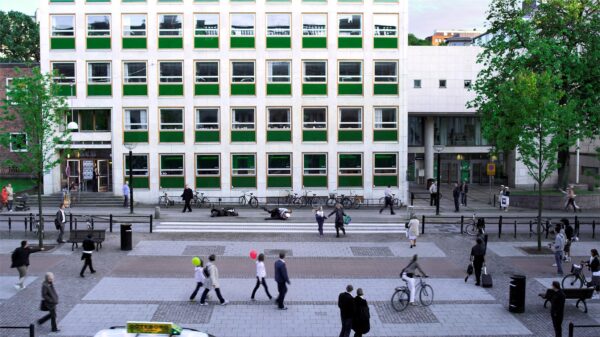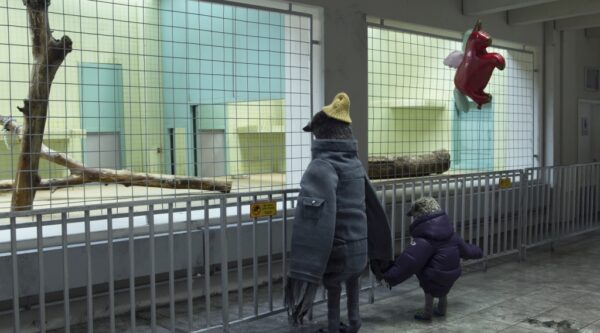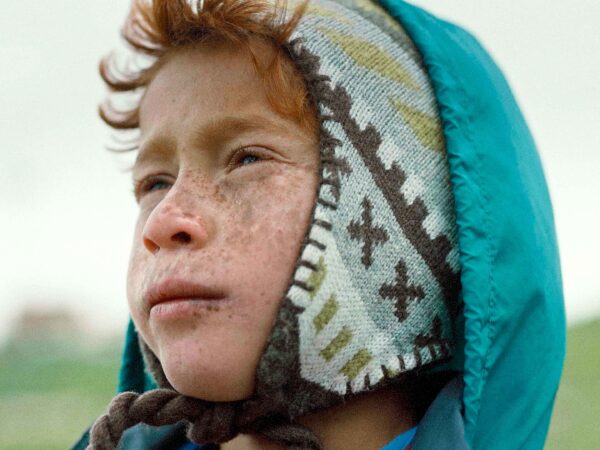Skirts Without Scots
Juck [Thrust]
The female dance group JUCK performs in public spaces. By scratching between their legs, the dancers reveal patterns of male dominance. Unfortunately, this film depicts their feminist activism as solely female.

A rhythmic beat, a close-up of a Celtic skirt, and a hand forming a fist. The mussels are constructing. The pelvis is repeating a robust and rhythmic thrust. Over and over again, the girls synchronously repeat the small but powerful movement of the pelvic thrust while they exhale in short, fast pushes and draw the viewer into a mantric spell. Many scenes in JUCK gain power from these intense images of physical strength. The female dance group JUCK, which is presented here in a mixture of documentary and fiction, performs in public places. By scratching between their legs or resisting glances, they reveal patterns of male dominance and excite them, reversing and questioning them in the process. Even the tartan skirts that all girls wear as group uniforms are symbols of male—in the truest sense of the word—phallic freedom.
Expressive scenes of female empowerment are shown with such power that one involuntarily feels the need to join this group as a woman due to the group dynamics. The powerful staging, with light and slow motion, especially contributes to the unique charisma of the girls. In many scenes of the film, they look rigidly into the camera and thus provocatively at the viewer, who cannot avoid their gaze. In these haunting glances lies an unbelievable power, a potential for change, social change. But there is something else in these glances. They keep the viewer away, create an extreme distance, and act as power mechanisms. These are the same mechanisms that patriarchy uses.
More often, the camera shows closed image sections in which the girls are seen as a group, and it becomes clear that they need each other as a group to strengthen each other, so doubt arises about the intended effect. One scene, in particular, is significant, in which the camera shows a whole hall full of women exercising the pelvic thrust movement in military lockstep. The feeling of belonging that is created here is the result of the strength of the group, i.e., the product of a group dynamic—but also through the apparent exclusion of another group, the men. Because only women participate in the new movement—as short video clips show—and only women are actively addressed. Therefore, the film unintentionally clarifies that the female movement of empowerment is a purely female movement with a female theme. But how can social change take place if half of society is not an active part of the discourse?
If I watch feminist films like Barbara Miller’s Female Pleasure in the cinema, the hall is full of women. The only man is the friend of one of the women. The critical question now arises: who will be addressed with the film? All the women in the cinema hall have dealt with the themes of feminism and equality between men and women. The group of society that did not do this is not in the cinema either. So what use is it if we women are aware of the problem, but men are not, because they do not feel addressed by it? Because de facto, the feminist discourse in the cinema mostly only appeals to women because they are the suffering group. Men do not watch such films voluntarily. At least this can be assumed if one considers the percentage of men in the cinema auditorium. What is the reason for this? For example, in the feminist movement, we often reproduce a system of exclusion instead of finding new forms of living together. And that’s also what Itch is about.
Is it necessary for this movement’s power that men are first excluded from it? And isn’t the introductory statement behind the exercise of this simple, rhythmic pelvic thrust of the girls, which we all first interpret as an imitation of an expression for male dominance, actually that “male” and “female” are not ontologically fixed terms? The girls address this, but they do not follow this thought. They create a power structure by repeating known patterns of patriarchy because, ultimately, it is the power of a particular group that is at stake here again. However, the power of one group always means the powerlessness of another.
Olivia Kasterbrings, Julia Gumperts, and Ulrika Bandeira’s film is an essential contribution to the relevance of gender issues in today’s society; as a reflection that something is happening, but also as a mirror of the fact that our system is still a patriarchal one. However, it should not be forgotten that this movement of empowerment takes place in still consolidated systems of patriarchy and that the expressions we use are expressions of that patriarchy. New thoughts and concepts would be necessary to break out of this structure—ideas that do not aim at exclusion and power but at equal togetherness. The question that our society must ask itself, and this film should also have asked itself, is: How can we include men actively in the process without excluding them from the discussion and pointing our fingers at them?




There are no comments yet, be the first!